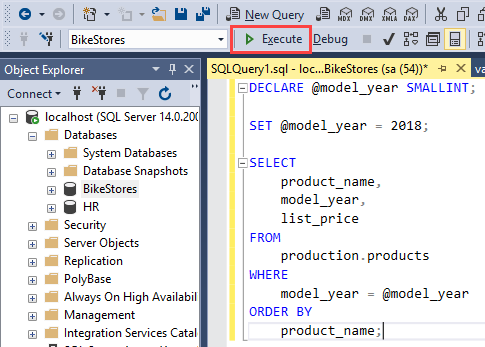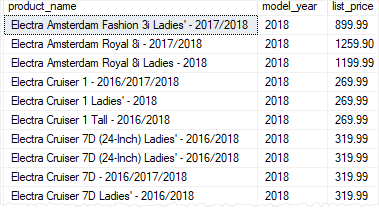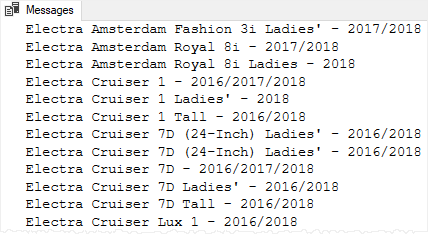Summary: in this tutorial, you will learn about variables including declaring variables, setting their values, and assigning value fields of a record to variables.
What is a variable
A variable is an object that holds a single value of a specific type e.g., integer, date, or varying character string.
We typically use variables in the following cases:
- As a loop counter to count the number of times a loop is performed.
- To hold a value to be tested by a control-of-flow statement such as
WHILE. - To store the value returned by a stored procedure or a function
Declaring a variable
To declare a variable, you use the DECLARE statement. For example, the following statement declares a variable named @model_year:
DECLARE @model_year SMALLINT;
Code language: SQL (Structured Query Language) (sql)The DECLARE statement initializes a variable by assigning it a name and a data type. The variable name must start with the @ sign. In this example, the data type of the @model_year variable is SMALLINT.
By default, when a variable is declared, its value is set to NULL.
Between the variable name and data type, you can use the optional AS keyword as follows:
DECLARE @model_year AS SMALLINT;
Code language: SQL (Structured Query Language) (sql)To declare multiple variables, you separate variables by commas:
DECLARE @model_year SMALLINT,
@product_name VARCHAR(MAX);
Code language: SQL (Structured Query Language) (sql)Assigning a value to a variable
To assign a value to a variable, you use the SET statement. For example, the following statement assigns 2018 to the @model_year variable:
SET @model_year = 2018;
Code language: SQL (Structured Query Language) (sql)Using variables in a query
The following SELECT statement uses the @model_year variable in the WHERE clause to find the products of a specific model year:
SELECT
product_name,
model_year,
list_price
FROM
production.products
WHERE
model_year = @model_year
ORDER BY
product_name;
Code language: SQL (Structured Query Language) (sql)Now, you can put everything together and execute the following code block to get a list of products whose model year is 2018:
DECLARE @model_year SMALLINT;
SET @model_year = 2018;
SELECT
product_name,
model_year,
list_price
FROM
production.products
WHERE
model_year = @model_year
ORDER BY
product_name;
Code language: SQL (Structured Query Language) (sql)Note that to execute the code, you click the Execute button as shown in the following picture:

The following picture shows the output:

Storing query result in a variable
The following steps describe how to store the query result in a variable:
First, declare a variable named @product_count with the integer data type:
DECLARE @product_count INT;
Code language: SQL (Structured Query Language) (sql)Second, use the SET statement to assign the query’s result set to the variable:
SET @product_count = (
SELECT
COUNT(*)
FROM
production.products
);
Code language: SQL (Structured Query Language) (sql)Third, output the content of the @product_count variable:
SELECT @product_count;
Code language: SQL (Structured Query Language) (sql)Or you can use the PRINT statement to print out the content of a variable:
PRINT @product_count;
Code language: SQL (Structured Query Language) (sql)or
PRINT 'The number of products is ' + CAST(@product_count AS VARCHAR(MAX));
Code language: SQL (Structured Query Language) (sql)The output in the messages tab is as follows:
The number of products is 204
Code language: SQL (Structured Query Language) (sql)To hide the number of rows affected messages, you use the following statement:
SET NOCOUNT ON;
Code language: SQL (Structured Query Language) (sql)Selecting a record into variables
The following steps illustrate how to declare two variables, assign a record to them, and output the contents of the variables:
First, declare variables that hold the product name and list price:
DECLARE
@product_name VARCHAR(MAX),
@list_price DECIMAL(10,2);
Code language: SQL (Structured Query Language) (sql)Second, assign the column names to the corresponding variables:
SELECT
@product_name = product_name,
@list_price = list_price
FROM
production.products
WHERE
product_id = 100;
Code language: SQL (Structured Query Language) (sql)Third, output the content of the variables:
SELECT
@product_name AS product_name,
@list_price AS list_price;
Code language: SQL (Structured Query Language) (sql)
Accumulating values into a variable
The following stored procedure takes one parameter and returns a list of products as a string:
CREATE PROC uspGetProductList(
@model_year SMALLINT
) AS
BEGIN
DECLARE @product_list VARCHAR(MAX);
SET @product_list = '';
SELECT
@product_list = @product_list + product_name
+ CHAR(10)
FROM
production.products
WHERE
model_year = @model_year
ORDER BY
product_name;
PRINT @product_list;
END;
Code language: SQL (Structured Query Language) (sql)In this stored procedure:
- First, we declared a variable named
@product_listwith varying character string type and set its value to blank. - Second, we selected the product name list from the products table based on the input
@model_year. In the select list, we accumulated the product names to the@product_listvariable. Note that theCHAR(10)returns the line feed character. - Third, we used the
PRINTstatement to print out the product list.
The following statement executes the uspGetProductList stored procedure:
EXEC uspGetProductList 2018Code language: SQL (Structured Query Language) (sql)The following picture shows the partial output:

In this tutorial, you have learned about variables including declaring variables, setting their values, and assigning value fields of a record to the variables.